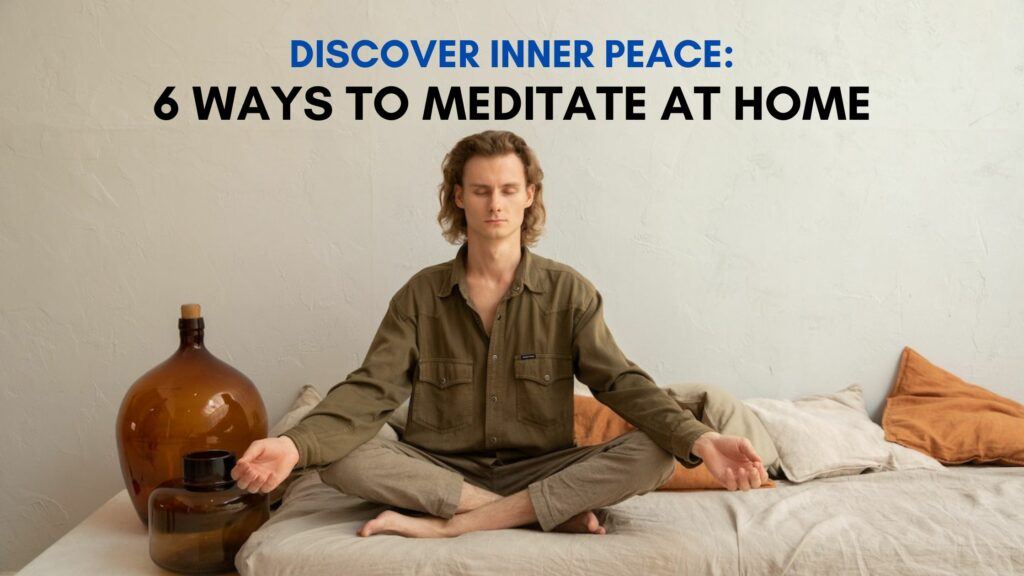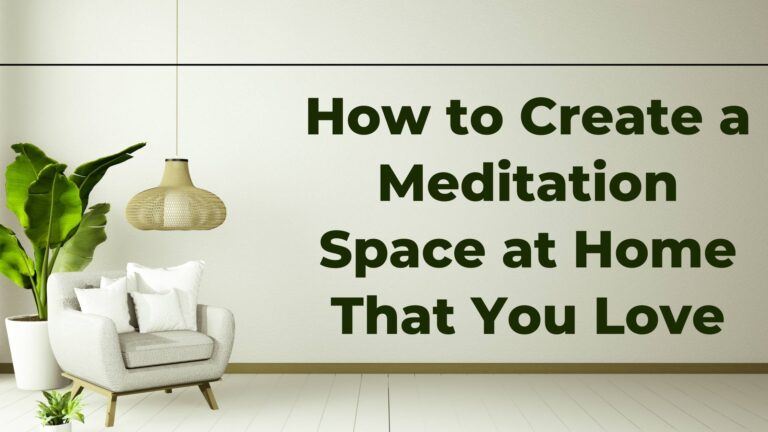What if one small change in your home could make it easier to stick with your meditation practice? Learning how to create a meditation space at home can help you feel more focused, relaxed, and motivated to meditate regularly. Whether you live in a spacious house or a small apartment, setting up a peaceful corner doesn’t have to be complicated.
In this post, you’ll discover practical tips for choosing the right spot, making it comfortable, and adding calming elements that support your inner peace so you can build a space that truly feels like your own.
1. Choose the Right Spot in Your Home
You don’t need a whole room to create a peaceful meditation space. A quiet corner or small area can work just as well. What matters most is how the space makes you feel.
Look for a quiet area
Pick a spot where you’re less likely to be disturbed. This could be a corner of your bedroom, a guest room, or even a space near a window. Try to avoid areas where people often walk by or talk.
Natural light is a bonus
If you can, choose a place with some natural light. Sunlight can lift your mood and make the space feel warm and welcoming. But if that’s not possible, soft indoor lighting works too.
Stay away from noisy spots
Avoid setting up your space near the kitchen, TV, or main hallway. These areas can be loud and full of movement, making it hard to stay focused.
Small space? No problem
Even if you live in a tiny home or shared space, you can still make it work. Try using a corner with a floor cushion, or store your meditation items in a small basket that you bring out when it’s time to sit. What matters is consistency, not size.
2. Declutter & Clean the Area
A clean space helps you feel calm and clear. Before you set up your meditation spot, take a few minutes to tidy it up.
Clear away anything you don’t need
Remove items that don’t serve a purpose in your practice. That might include books, laundry, gadgets, or random clutter. The less you have around you, the easier it is to focus.
Wipe down surfaces & freshen the air
Dust the area, sweep the floor, and open a window if possible. A clean space feels lighter and more welcoming. You can also use natural scents like sage or essential oils to refresh the air.
Keep only calming or useful items
Only leave what helps you feel relaxed. This might be a cushion, a blanket, a candle, or a small plant. These items can help set the tone for stillness without being a distraction.
Put away electronics
If your phone or other devices are nearby, turn them off or place them outside the space. Notifications and screens can pull your attention away from the moment.

Turn your living space into a sacred space
You don’t need a fancy studio or hours of free time to feel grounded.
Discover 6 easy ways to meditate at home, ideal for finding calm in your living room, bedroom, or any cozy spot.
Begin your journey to a calmer life, right where you are.
3. Choose a Comfortable Seat
How you sit can affect how long and how well you meditate. A seat that supports your body makes it easier to stay still and relaxed.
Use what feels good for your body
You don’t need a fancy cushion or bench. A folded blanket, yoga mat, or even a sturdy chair can work. The goal is to find something that lets you sit upright without strain.
Comfort is more important than perfect posture
You don’t need to sit in the lotus position. If crossing your legs is uncomfortable, sit with your legs outstretched or use a chair. What matters most is feeling steady and relaxed.
Add a blanket or shawl if needed
Sometimes, you may feel cold while sitting still. Keep a soft blanket or shawl nearby to stay warm and cozy during your practice.
Support helps reduce distractions
When your body is well-supported, you’re less likely to shift around or get distracted by aches. This helps you stay focused and enjoy your meditation more.
4. Add Elements That Inspire Calm
The things you place in your meditation space can help set the mood. Choose items that help you feel peaceful and grounded.
Use soft lighting
Bright lights can feel harsh and distracting. Try a salt lamp, small lamp, candles, or string lights. Soft lighting makes the space feel warm and gentle.
Pick calming colors
Colors can affect your mood. Soft colors like beige, grey, light blue, or green often feel soothing. You don’t need to repaint, just use a mat, cushion, or fabric in a calming color.
Add relaxing scents
Smells can help you settle into the moment. Use incense, a candle, or an essential oil diffuser with calming scents like lavender, sandalwood, or eucalyptus. Keep it light, too much scent can be overwhelming.
Include natural elements
Bringing nature into your space can add a sense of peace. A small plant, a few stones, shells, or a bowl of water can connect you to the natural world and help you feel grounded.

How to make meditation a part of your daily routine
If you’ve ever said, “I want to meditate, but I don’t know how to start,” this is the guide for you.
Learn how to build a sustainable meditation routine that works for real life, even if you only have 5 minutes a day.
Start your journey to inner calm with simple steps NOW!
5. Personalize Your Sacred Space
Your meditation space should feel special and meaningful to you. Adding personal touches can help you connect more deeply with your practice.
Add items that have meaning to you
This could be a small statue, a crystal, prayer beads, or a photo that brings you peace. Choose objects that remind you of your values or spiritual path.
Keep a journal or intention card nearby
Writing down a short intention before you sit can help guide your focus. You can also keep a journal nearby to reflect after your session.
Create a small altar or shelf
If you like, set up a small area to hold your meaningful items. It doesn’t need to be fancy. A simple tray or shelf can create a clear and sacred spot within your space.
Let it reflect your personality
There’s no right or wrong way to decorate your space. What matters is that it feels right to you. Choose items that calm you, inspire you, or help you feel more present.
6. Create a Ritual Around Your Practice
A simple ritual can help you shift into a calm and focused state. It signals to your mind and body that it’s time to slow down.
Start with a calming action
Light a candle, ring a bell, or take a few deep breaths before you begin. Doing the same action each time helps you settle into the moment more easily.
Play gentle music or nature sounds
If silence feels hard, soft background sounds can help. Try quiet music, ocean waves, or birdsong whatever helps you feel at ease.
Stick to a regular time
Try to meditate at the same time each day, even if it’s just for a few minutes. A regular schedule builds the habit and makes it part of your routine.
End with a closing ritual
Mark the end of your session with a simple action. You could take a deep breath, bow your head, or say a word of thanks. This helps you carry the calm into the rest of your day.
Final Thoughts
Creating a meditation space at home doesn’t have to be hard or expensive. With a little thought and care, even a small corner can become a peaceful place where you feel calm and focused. Choose a quiet spot, keep it clean, and add items that make you feel at ease. Most importantly, make it your own. The more your space supports your practice, the more likely you are to return to it day after day. Start small, and let it grow with you.
Want to live more mindfully without adding pressure to your day?

Discover how the Mindful Living Bundle, with its journal and affirmation deck can help you build a meaningful mindfulness routine that sticks.
Explore the full bundle and see how it can transform your daily routine.
Don’t just read about it, experience it for yourself.

